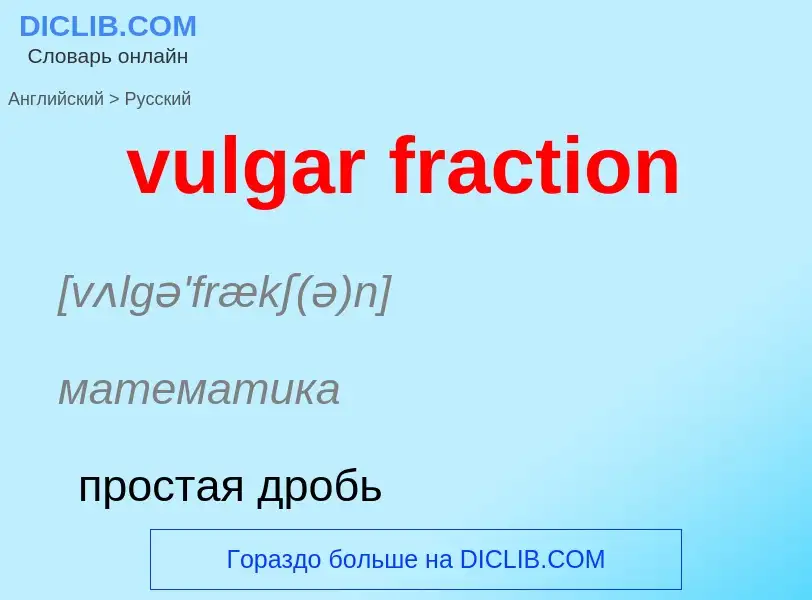Traduzione e analisi delle parole tramite l'intelligenza artificiale ChatGPT
In questa pagina puoi ottenere un'analisi dettagliata di una parola o frase, prodotta utilizzando la migliore tecnologia di intelligenza artificiale fino ad oggi:
- come viene usata la parola
- frequenza di utilizzo
- è usato più spesso nel discorso orale o scritto
- opzioni di traduzione delle parole
- esempi di utilizzo (varie frasi con traduzione)
- etimologia
vulgar fraction - traduzione in russo
[vʌlgə'frækʃ(ə)n]
математика
простая дробь
дробь простая
общая лексика
смешанная дробь
Definizione
Wikipedia
A fraction (from Latin: fractus, "broken") represents a part of a whole or, more generally, any number of equal parts. When spoken in everyday English, a fraction describes how many parts of a certain size there are, for example, one-half, eight-fifths, three-quarters. A common, vulgar, or simple fraction (examples: and ) consists of a numerator, displayed above a line (or before a slash like 1⁄2), and a non-zero denominator, displayed below (or after) that line. Numerators and denominators are also used in fractions that are not common, including compound fractions, complex fractions, and mixed numerals.
In positive common fractions, the numerator and denominator are natural numbers. The numerator represents a number of equal parts, and the denominator indicates how many of those parts make up a unit or a whole. The denominator cannot be zero, because zero parts can never make up a whole. For example, in the fraction 3/4, the numerator 3 indicates that the fraction represents 3 equal parts, and the denominator 4 indicates that 4 parts make up a whole. The picture to the right illustrates 3/4 of a cake.
A common fraction is a numeral which represents a rational number. That same number can also be represented as a decimal, a percent, or with a negative exponent. For example, 0.01, 1%, and 10−2 are all equal to the fraction 1/100. An integer can be thought of as having an implicit denominator of one (for example, 7 equals 7/1).
Other uses for fractions are to represent ratios and division. Thus the fraction 3/4 can also be used to represent the ratio 3:4 (the ratio of the part to the whole), and the division 3 ÷ 4 (three divided by four). The non-zero denominator rule, which applies when representing a division as a fraction, is an example of the rule that division by zero is undefined.
We can also write negative fractions, which represent the opposite of a positive fraction. For example, if 1/2 represents a half-dollar profit, then −1/2 represents a half-dollar loss. Because of the rules of division of signed numbers (which states in part that negative divided by positive is negative), −1/2, −1/2 and 1/−2 all represent the same fraction – negative one-half. And because a negative divided by a negative produces a positive, −1/−2 represents positive one-half.
In mathematics the set of all numbers that can be expressed in the form a/b, where a and b are integers and b is not zero, is called the set of rational numbers and is represented by the symbol Q, which stands for quotient. A number is a rational number precisely when it can be written in that form (i.e., as a common fraction). However, the word fraction can also be used to describe mathematical expressions that are not rational numbers. Examples of these usages include algebraic fractions (quotients of algebraic expressions), and expressions that contain irrational numbers, such as (see square root of 2) and π/4 (see proof that π is irrational).

